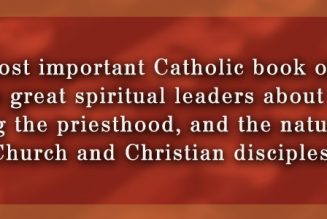
A generation ago we bemoaned the many uncatechized Catholics sitting in the pews. Many of the children of that generation are now Millennials who have wandered beyond uncatechized to unchurched. They rarely attend Mass, if ever, and neither do their young children. The statistics identify these parents among the least religious groups in American history. The Catholic Faith is as vague a notion to them as quantum physics or calculus.
Is Catholicism in America doomed when the vast majority of the baptized—the 80% who stay home on Sunday—are unchurched?
In former generations, handing on the Faith occurred through a confluence of factors. The primary two were liturgical—the Mass, celebrations of saints, May crownings, Eucharistic processions—and educational—direct instruction in the Faith in school, often by men and women religious. Enhancing these weekly or periodic happenings was a Catholic culture, that is, a Catholic way of living in the world, that included family prayer, crucifixes in the home, meatless Fridays, Lenten penances, rosaries, Saturday confession, bingo in the church basement, and living among other Catholics in a particular neighborhood.
“Christian culture,” writes Christopher Dawson in The Crisis of Western Education (1961), “is the embodiment of Christianity in social institutions and patterns of life and behavior.” Hence, for most Catholics, this culture was caught, rather than taught, and it served as the cement foundation for Catholics’ beliefs. In Dawson’s telling, “[a]rchitecture and painting and sculpture, music and poetry were all enlisted in [Christian culture’s] service, and no one was too poor or too uneducated to share in its mysteries.” In America, before Vatican II, Catholics were very much aware that their culture was distinct from the broader American Protestant culture that dominated the nation.
Today, all the cultural edifices that buttressed the liturgy and education in handing on the Faith are gone. Secularity permeates all aspects of American life, while actions once condemned as immoral masquerade as normal. A distinctly Catholic way of living disappeared with meatless Fridays; devotions are the purview of the elderly; processions have ceased. Catholic art and architecture were deliberately wrecked and the parish has long ceased to be the locus of activity for Catholic families. Now, on Sunday mornings, Millennial parents drive their children not to church but to the athletic field, and precious few are shuffling into the 5:00 p.m. Mass at day’s end.
I have been observing how marginal Catholics live without the support of Catholic culture in two years of teaching baptism preparation in my parish. Almost none of the new parents, ranging in age from the early thirties to the early forties, who attend the singular mandatory session practices the Faith. While there is enough spiritual residue within them to seek baptism for their children, they have no connections to the institutional Church and a tenuous one to my parish. Almost all of them are relatively new to town and have yet to attend a Mass, or they are out-of-towners with a faint natal connection to the parish. When we enter the church, no one genuflects; regularly, a new dad continues to wear his baseball cap.
What chance does our sixty-minute session stand to spark their faith when it is the single religious raindrop in the vast secular ocean of their lives? The same analogy can be extended with slight revision to Catholics who attend Mass on Sundays but otherwise sail the same ocean. It is frightening to wonder what parish attendance will look like in thirty years, when the Millennials are collecting Social Security and the children they never took to church but had baptized become the parents of the rising generation.
What is the remedy to this situation?
Frankly, while efforts to evangelize through sacramental preparation must continue by our Lord’s command, I think the likelihood of success—leading these people to love God through regular Catholic practice—is minimal. Why? Whatever can be said about the state of the liturgy since Vatican II, the fact is that Mass each Sunday has been the one constant in American Catholic life. Which leads me to conclude that the Mass alone, without the broader cultural support of “Catholic living,” cannot keep Catholics in the fold.
Dawson is right: religion needs culture to grow as a seed needs good soil. Today the soil that is American culture is infertile, and prospects for its renewal in the near-term are non-existent. Without the support of a healthy Catholic culture, today’s marginal Catholics are like the seeds sown among the thorns; they are men and women “who [hear] the word, but the cares of the world and the delight in riches choke the word, and it proves unfruitful” (Mt 13:22).
Is there any soil to cultivate today so at least some Catholic seeds may survive and bear fruit? I believe that a triangular-shaped garden fertilized with three nutrients—the family, the parish, and the Catholic school—can offer enough fertile soil for a counterculture to develop. All three, with their unique emphases, can provide the cultural elements necessary to support faith growing within parents and their children.
The effort must be intentional, with all three points operating in unison with the same level of understanding, and openly critical of the prevailing secular culture that bursts through our screens with hurricane strength throughout the day. Young people will be willing to stay rooted in the countercultural Catholic garden only if they both feel the benefits of remaining there while also seeing the flaws of the secular culture. The rule in sports applies for evangelization: the best defense is a good offense.
The seeds desired for this triangular garden are not the marginal Catholics, but those who have some active ties to the Church through attendance at Mass or enrollment in Catholic schools. If we want the seed of faith to grow in this hostile American culture, we have to work three times as hard to give them countercultural conditions to grow. Parishes should increase adoration, devotion, and procession opportunities, and implore parents and their children to participate. Consider the impact, for example, that dressing ten boys in cassock and surplice and then giving them a role in an outdoor Eucharistic or saint procession can have, especially if they practice beforehand and are given an understanding of what exactly they are doing. Parish priests ought not hesitate to criticize the prevailing secular culture in their homilies and explain how a Catholic counterculture is healthier, more fulfilling, more in keeping with human dignity and human flourishing.
Catholic schools should take every opportunity—from marketing to school assemblies to regular classroom instruction—to extol the virtues of Catholic culture while exposing the vices of secular culture and its training ground: government schools. On one level, when it comes to academics, math is math and science is science; but when confident teachers seize a few occasions to show how math and science point to a benevolent Creator God who made everything in the universe to share in His love and to reflect back to Him, they will have contributed mightily to supporting the faith of their students. In history and literature courses, there is no reason why saints and Catholic writers cannot be included within curricula alongside the likes of George Washington and Washington Irving. When this happens, students see that religion is a natural part of culture, not something to be separated from culture. In American history alone, there is no shortage of saints who heroically labored, to use a secular phrase, to raise the standard of living for the most marginalized among us. In a society obsessed with racial issues, lessons can begin with Saints Junipero Serra and Katherine Drexel. Outside the classroom, schools can sponsor family and religious events that draw Catholics together in community.
Vatican II’s Lumen Gentium calls the family the “domestic church” because “[i]n it parents should, by their word and example, be the first preachers of the faith to their children” (11). It is here where the faith given through the Church in baptism takes root. The parish and the school have to urge parents and children to tend to their faith development at home, and today there is no shortage of print and electronic resources to help supplement their efforts and to provide, in absence of a Catholic neighborhood, an understanding of how to live the Catholic faith in daily life. Parents have to be aware that they and their children are different from their peers for choosing a distinctly Catholic life, and they have to fortify themselves against peer pressure to conform. This is another reason that the countercultural garden needs the three anchors: standing alone against the prevailing cultural tsunami is no easy feat, especially not for children and adolescents.
It’s been popular in recent years to call strategies for living the faith “options,” following Rod Dreher’s “Benedict Option.” I will follow suit and call my triangular garden the “Seminary Option” for a simple reason: if we want the Catholic faith to survive in America, we need to sow seeds in our countercultural garden. Then we must pray and work that these seeds will grow to build up the cultural elements necessary to sustain the faith. We pray that the seeds will have born fruit that will last, as will be evident when more Catholics leave the margins to plant their families in this same garden.
A new Catholic counterculture can then withstand all threats from the outside: “He is like a tree planted by streams of water, that yields its fruit in its season, and its leaf does not wither. In all that he does, he prospers” (Psalm 1:3).
If you value the news and views Catholic World Report provides, please consider donating to support our efforts. Your contribution will help us continue to make CWR available to all readers worldwide for free, without a subscription. Thank you for your generosity!
Click here for more information on donating to CWR. Click here to sign up for our newsletter.







![TikTok is making sea shanties big again [note: skip the first video and jump down to the various ‘Wellerman’ mixes]…](https://salvationprosperity.net/wp-content/uploads/2021/01/tiktok-is-making-sea-shanties-big-again-note-skip-the-first-video-and-jump-down-to-the-various-wellerman-mixes-327x219.jpg)

